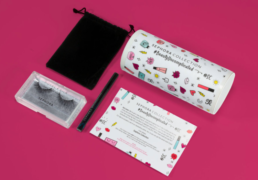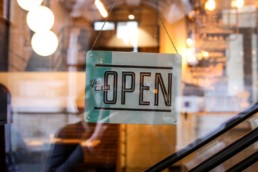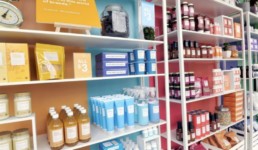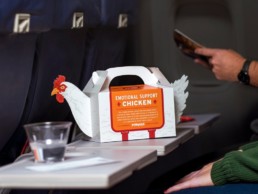Using Kits to Provide In-Person Experiences at Home
Loyalty
With the changing behaviors going on in the world right now VBX Solutions knows education attractions are some of the hardest hit companies regarding the new norms created by the pandemic. How can you provide your customers with a personal experience your education attraction would normally offer in-person, from a distance?
VBX Solutions has been trying to find the perfect idea to help our clients make the most out of the situation and we have the solution. We have seen huge success with the education kits, and we are going to tell you why. When you think about what your attraction is really offering it’s not only the knowledge you have to share, it’s also the experience of being able to physically see, touch, and listen to something your customers are interested in. An education box can replicate that emotional bond customers would normally feel from visiting your establishments. People are so eager to get back to a pre coronavirus world and supplying them with an experience in a box is a great way to do just that.
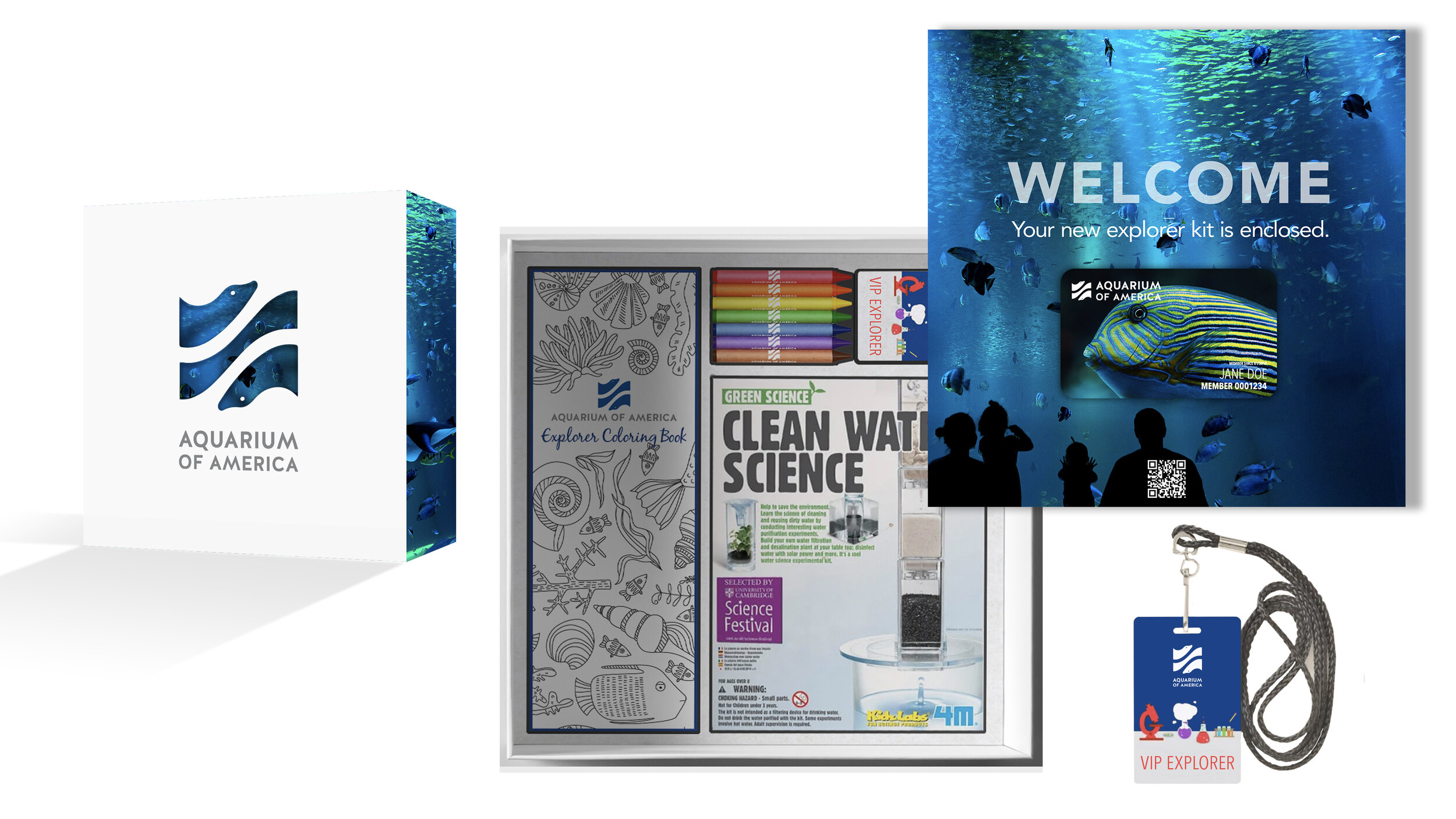
This sample education kit we created provides information this aquarium has to offer as well as fun ways to get engaged. Visiting an attraction provides customers with an experience as well memories with loved ones to last a lifetime so why not send that home to them.
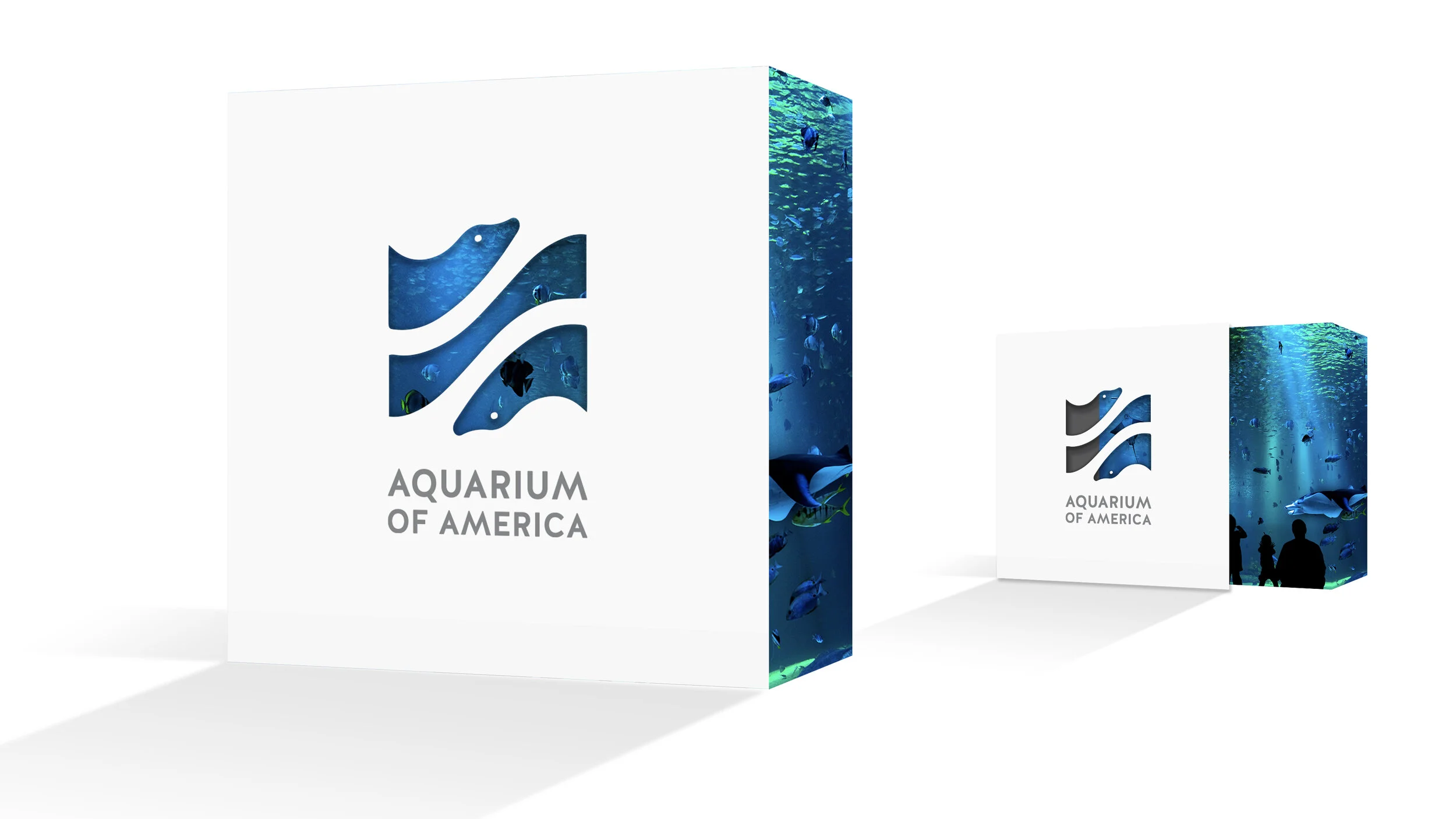
Booklet
· The kit comes with a booklet that provides mom and dad with information about all the perks of membership with the aquarium.
· It also provides them with fun and engaging activities for the whole family to get them involved with each other and your business.
o i.e. Take your kids to a nearby creek and see how many creatures they can name.
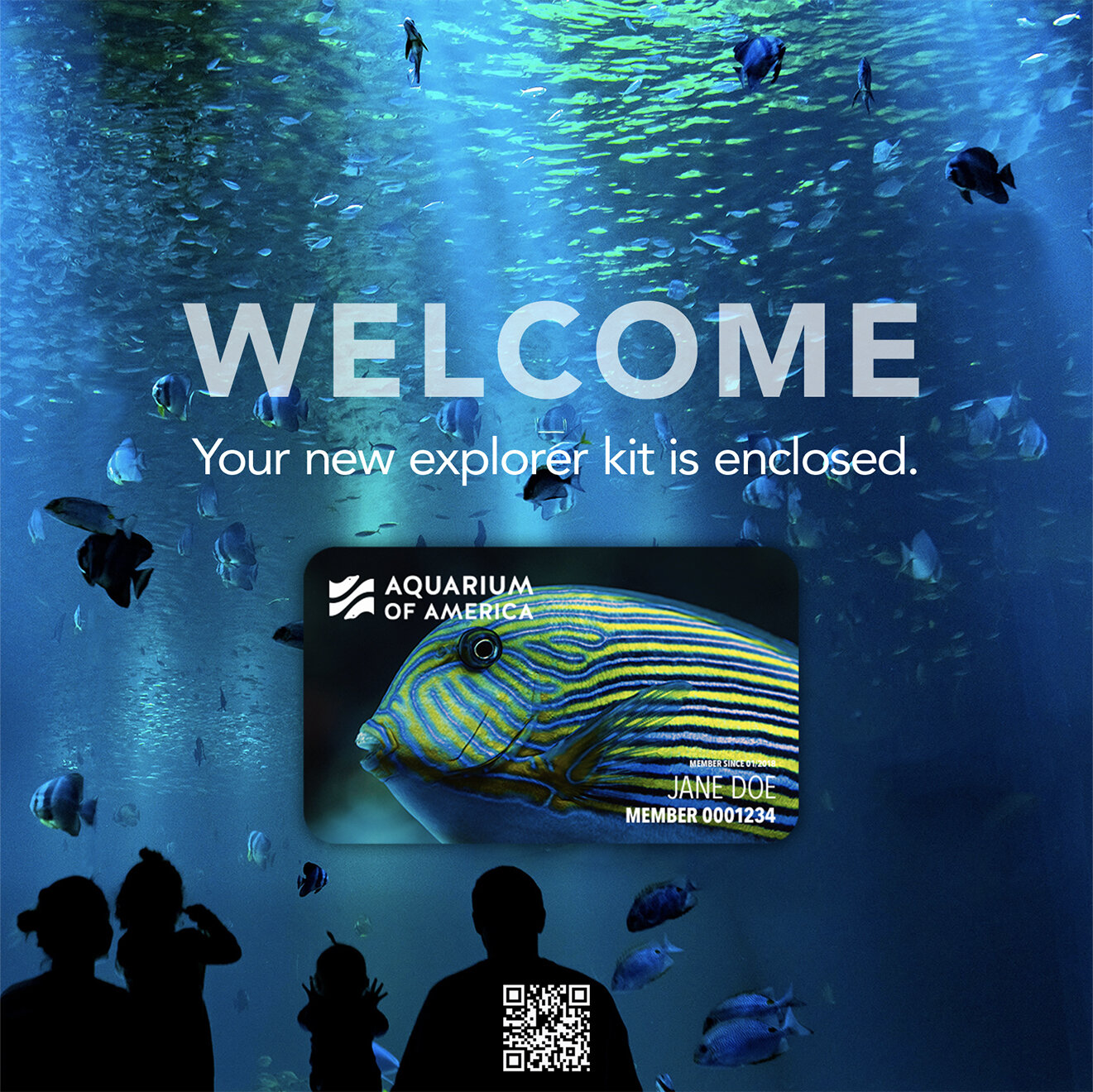
QR Code Attachment
· A QR Code is placed on the information booklet. This QR Code leads to more information about the animals in the aquarium and online games.

Explorer Coloring Book and VIP Pass
· The coloring book supplied has fun images of aquatic life and comes with a set of crayons.
· The package includes a fun “VIP Pass” to get kids eager about the opportunity to visit the aquarium when it is open.
Experiment
· This educational kit provides a clean water experiment for the whole family to do.
· Sending an experiment home to customers gives them an interactive piece of the aquarium as well as a way for the entire family to get involved and spend time together.
The entire VBX Solutions team plays a role in the lifecycle of getting kits like these prepared to go, but where the process really begins and ends is with our clients. Before we start designing any kit, we meet with the client to determine their goals, objectives, and KPIs.
From there, our Creative team gets to work on designing the package based off of what the clients goals are. From mood boards to sketches to prototypes, our team creates a multitude of concepts that support your brand’s promise.
Once the design is complete the manufacturing process begins and materials are collected from around the world to create the perfect package.
While the packaging is being manufactured our project managers start sourcing kit elements, identifying brands and content to include in the kit.
Finally, the packaging and content arrive at our fulfillment center where it is kitted and either stored in our warehouse awaiting drop shipment or is delivered to the client’s distribution center

With all the changes being made to the norms of society it is important for businesses to keep their target market engaged with what they have to offer. Providing clients with the experience of your establishment from the comfort and safety of their own home is a great way to show them you care about their loyalty. VBX Solutions would love to help you with taking that next step to go above and beyond with your customers. VBX Solutions can help you pinpoint ways to more effectively keep your target market interested in you and help navigate through any sore spots your business may be suffering from. Email us at info@vivaboxsolutions.com to discuss what we can do to help your education attraction flourish during these hard times.
Looking for a solution? We can help.
Headquarters
9211 Corporate Blvd Ste 110
Rockville MD 20850
Satellite Offices
Dallas, TX
Paris, France
San Francisco, CA
Scottsdale, AZ
info@vivaboxsolutions.com
Phone
800-529-1988
Minimum Order Quantities:
RPET Totes: 3,000
Kraft Shoppers: 5,000
Rigid Boxes: 3,000
Folding Cartons: 5,000
The Top Five Benefits of Outsourcing Your Packaging Strategy
Loyalty
The outsourcing of branding and promotions to marketing agencies for a brand is not a new strategy. It has been a proven practice since agencies opened their doors. At the same time, there are branding strategies that are always changing, so there is a steady learning curve to keep up with. Competing brands and the ever-changing demands of consumers challenge in-house teams to stay on top with new trends while maintaining day-to-day work, and has created the perfect storm of requirements. Nowhere is this more recognized than with packaging.
Consumer demands for packaging change often, especially when they require seasonal designs, more versatile uses, product variety, convenience, GWP, a more eco approach, and product protection. Since packaging is as important as every other element of a brand (arguably a top 3 priority), these ever-changing demands impact every packaging brief, at least they should.
In-House Pain Points
As one of the only physical touchpoints consumers have with a brand, and as consumers grow more averse to talking to real people or asking for help in stores, packaging has become more relevant than ever. These trends have made it hard for in-house marketing departments (and those stand-alone marketing agencies) to keep up the juggling act. Packaging demands are simply changing too fast and becoming more prevalent in consumer purchasing decisions. Those demands are more than the logo, a brand voice, or attribute call-outs, this also means meeting packaging regulations, material, and shipping cost projections, and accessibility to the machinery that makes the packaging, not to mention the right assembly and quality controls and getting them delivered on time to the right distribution centers
Mental and financial resources are tight in business. Businesses may see the opportunity to design a new category or put a product in to fill a gap or new customer demand, but the company is not structured efficiently to capitalize. They might prefer to source the product directly, but there are no custom-ready solutions. It takes time and work to deliver a customized “only available at” product, but who has time to do that when executing the current business plan? There are frictions – working with brand standards, legal approvals, and logistics systems that are hard to navigate. In the end, it’s a great idea, but too complicated to execute.
Operational costs, space limitations, additional labor costs, and logistical planning are all financial and time-management expenses most businesses cannot afford to take on in-house.
The Benefits of Outsourcing
This is why outsourcing, especially with unique SKU development, custom packaging, seasonal packaging, and new product or loyalty kits, has become a must for a wide range of businesses to keep up with growing customer demand and stay ahead of the competition.
“A third-party product management (3PPM) provider is an extension of your business,” Vivabox COO, Peter Allen, said. “It manages anywhere from a single SKU to an entire product line of a company’s portfolio and executes product design, creative development, sourcing, manufacturing, and shipping into your distribution centers. You get to focus on the marketing and selling activities, and the rest is taken care of for you by the 3PPM.”
Allen has collaborated with several companies who struggle with in-house packaging. For most, the packaging is an animal they simply cannot tame because it requires several moving parts that cost time and money. When a packaging company is a 3PPM provider, the sole focus is building the best packaging solutions for the brand. It has the knowledge a packaging company should have, which allows companies to focus more on what they do best for their brand and leave the packaging logistics to the experts.
Here are the top 5 benefits companies experience when working with a 3PPM packaging provider, like Vivabox:
-
We help lower costs of product acquisition and design, and we can rapidly respond to changing trends in the industry.
-
We can help with a single SKU, or we can build entire categories for your brand.
-
We become an extension of your business, supporting you with account managers that learn how your business executes and tailors our process to meet your requirements.
-
We work with your teams—creative, marketing, finance, operations, and legal to make the process seamless—saving an average of 9 hours per person, per month involved in the project on the client-side
-
We align with your business and bring you expertise from outside and inside your category to help you see new opportunities.
If you find yourself in a position where you would greatly benefit from a 3PPM, but you are not sure where to begin, Vivabox Solutions can help. We have the capabilities to fill multiple roles in your business. We take concepts and bring them to life with creative strategies, all the way to building and delivering that product concept to you and serving it up for you to sell.
Learn more by contacting Vivabox.
Looking for a solution? We can help.
Headquarters
9211 Corporate Blvd Ste 110
Rockville MD 20850
Satellite Offices
Dallas, TX
Paris, France
San Francisco, CA
Scottsdale, AZ
info@vivaboxsolutions.com
Phone
800-529-1988
Minimum Order Quantities:
RPET Totes: 3,000
Kraft Shoppers: 5,000
Rigid Boxes: 3,000
Folding Cartons: 5,000
Using Customer Loyalty Programs in Retail
Loyalty
With the rise of big-box stores, online shopping giants, and same-day deliveries, the retail landscape has changed dramatically in a relatively short period of time. Consumers now have the freedom and flexibility to shop for virtually anything, any time of day, and enjoy affordable pricing, free shipping, and other perks that were once unheard of in the retail world. Because of this, the competition between retailers has never been more fierce. It is getting increasingly difficult to build and retain consumer loyalty with so many options available to shoppers nowadays. This seismic shift in how people purchase necessities and luxury items has caused a struggle among retailers to keep up with changing trends, as well as a constant search for a magic formula to stand out against competitors.

One of the most popular ways retailers maintain a healthy, thriving customer base is through loyalty programs. Many larger retailers offer customer loyalty programs that offer discounts and rewards earned through purchases. This strategy is effective not only by giving consumers an added incentive to do their business with a particular store, but also by ensuring that customers are likely to spend even more money when they return to use their reward points or earned discounts.
What Makes a Customer Loyalty Program Successful?
In order for a retail customer loyalty program to gain success among its target audience, it should meet the following requirements:
No Cost to Join
If a customer loyalty program is free, customers are far more likely to sign up than if there were a monthly or annual membership fee. While some retailers do offer rewards programs that cost money to subscribe, the free loyalty programs are almost universally more successful and popular than the ones that charge.
Keep in mind, however, that in order for a retailer to support a free rewards program, they must be able to cover the costs of the goods or services that are being given away or reduced in price. A prime example of this is the Starbucks rewards program, which is free to join and incredibly popular among its customers. Recently, customers could receive any menu item for free each time they earned 125 stars, at the rate of one star for each dollar spent in the store. Additionally, certain promotional events allowed customers to earn double or even triple stars on special days or at off-peak, “happy hour” times of the day. However, Starbucks recently had to change its reward redemption structure, as it became clear that customers were using their earned rewards stars toward big-ticket items, such as salads and sandwiches, rather than much-cheaper cups of coffee. The rewards program now operates on a tier system, but this has not seemed to hinder the success of the program.
User-Friendly
From the basic structure of the customer loyalty program to the ease and convenience with which points can be redeemed online, user experience is everything. When rolling out a new customer loyalty program, a retailer must make sure that both the desktop and mobile website or app supporting the earning and redemption of points is intuitive, convenient, and simple to use. Additionally, the structure of the program should be easy to understand and clearly laid out to avoid confusion and frustration among customers.
Not surprisingly, the Amazon Rewards Visa is one of the most user-friendly customer loyalty programs in existence. A digital native, Amazon has always led the pack when it comes to innovating online retail systems, and its rewards program is no exception. Though becoming a Rewards Visa member does require signing up and being approved for an Amazon credit card, after that, the reward points are as easy to redeem as they are to earn – both on and off the Amazon website. Even more importantly, members are able to access their point balance and view past transactions, earned reward points, and more on the website or mobile app, making it convenient, easy, and, as Amazon itself would say, “frustration-free.”
Great Incentives
As consumers everywhere can probably tell you, not all customer loyalty programs are created equal. Some retailers, for example, offer things like “store cash,” which can be redeemed only during select weeks and take a percentage off of a future purchase, rather than giving a customer anything for free. A good rewards program should offer a healthy balance of same-day discounts and the ability to redeem points toward free items. Some of our favorite incentives give the consumer a choice of special addition kits which make them feel rewarded while also introducing them to new products.
However, the ease with which customers can receive rewards is just as important as the incentives themselves. A number of customer loyalty programs tend to make people spend far too much before parting with even the smallest incentive on the tier. Movie theater rewards programs are a notorious offender, forcing rewards members to spend literal hundreds of dollars on ticket and concession purchases before even being granted a free small popcorn valued at five dollars!
No Expiration Date
A reward earned should be a reward kept. However, some retailers have structured their customer loyalty programs to include expiration dates for discounts and free items, even though a consumer has earned the points fair and square. The expiration date strategy is a purposeful one, designed to make customers come back sooner. However, it can be a major turnoff to earn enough points for a large reward, only to be told by a sales associate that those points expired one week ago! By structuring a customer loyalty program with no expiration dates, you are showing customers that you value them as people, not dollar signs.
Chick-Fil-A does a very nice job of handling the balance between when points are earned and when they are redeemed. Their loyalty program allows customers to spend their accumulated points either little by little or in one lump sum. A customer can use the Chick-Fil-A mobile app to easily keep track of how many points they have earned, as well as which free reward items are available to them. Once a customer redeems a reward, it becomes a coupon that is only available for 24 hours, but since most customers wait to redeem their reward points until they are already at the restaurant, this system does not cause confusion or frustration for anyone involved.
By keeping your customer loyalty program simple, free, and easy to use, you will be able to provide incentives that entice consumers to keep coming back to your retail store over and over again. Follow these guidelines when structuring your customer loyalty program and you will have a devoted customer base in no time. How can Vivabox help you create a successful loyalty program? Contact us to find out.
Looking for a solution? We can help.
Headquarters
9211 Corporate Blvd Ste 110
Rockville MD 20850
Satellite Offices
Dallas, TX
Paris, France
San Francisco, CA
Scottsdale, AZ
info@vivaboxsolutions.com
Phone
800-529-1988
Minimum Order Quantities:
RPET Totes: 3,000
Kraft Shoppers: 5,000
Rigid Boxes: 3,000
Folding Cartons: 5,000
O2O: Bridging the Gap for the Online-to-Offline Consumer Experience
Loyalty
As e-commerce becomes more prevalent year-over-year, online and brick & mortar stores (and even DTCs) are scrambling for consumer attention. At the same time, demands for extraordinary experiences grow from both a digital and a physical retail point of view, but from the consumer perspective and certainly from the brand perspective, there is a struggle between the two worlds when it comes to how they work together.
Enter O2O: Online-to-Offline commerce.
O2O is a business strategy designed to bring online customers to brick & mortar locations, as well as create a seamless digital experience before, during, and after their purchases.
Many factors conspired together to create the need for an O2O strategy, but the most important one is that consumers see desktop-mobile-physical shopping and buying as fluid while many companies and brands distinguish them, set attribution targets for each, train and incentivize employees in silos, and make it hard to share data between digital and physical interactions.
The positive spin and the core of O2O strategy? More touchpoints and more opportunities.
Gone are the days of warehouse shelving and big brown boxes stuffed with peanuts and bubble wrap–consumers are driving expectations higher while asking for eco alternatives and at-my-fingertips convenience all at the same time and from every step of the buyer journey.
According to a December 2018 Shopify article, “Every brand wants to capture its market in totality, to reach customers new and old through mediums on-site and off. Today if your company doesn’t have a multi-channel marketing strategy…good luck keeping up.”
This means providing online, brick & mortar, catalog, mobile, and social options in unison. The article also explains that, on average, multi-channel marketing and selling increases revenue by 38%, 120%, 190% with each additional channel respectively.
This kind of growth is considerable and needed in today’s retail climate. However, one area that still gets left unnoticed is how one bridges the online/on-site gap.
Typically, businesses offer consumers choices: they can buy online and have it delivered, or they can go to a store and make a purchase. But what about those who research online and then go to the store to make their purchase? What happens when they order a product and want to pick it up in-store? More so, how do businesses convince consumers to buy online and pick up in store to not only create a more well-rounded shopping experience but to also create their own unique experience and brand-in-hand experience? What is the incentive for consumers to do both?
The answer lies in the conversation that already surrounds O2O. The known benefits of O2O commerce allow businesses to treat online and offline channels as complementary rather than competitive.
- Rapid in-Store pickup of products purchased online
- Online purchase of products while at a physical store (quantity, size, color variations and more vs a lost sale)
- Physical store returns & exchanges for online purchases
- Additional incentives and well-rounded shopping experiences when customers combine online and offline purchases
- A combination of online tracking to offer personalized shopping experiences while consumers are actively shopping
- New opportunities for trial and loyalty program engagement.
Research shows that many customers still want to have shopping experiences that allow them to have tangible interactions with the products they want to buy, but they don’t want to give up their technology.
In a recent study by CBRE Group, discovered that even younger people prefer an in-store, tangible shopping experience. The survey showed that 70% of millennials prefer shopping in stores, even though they spend an average of 7.5 hours a day online. This is one of the top reasons some 22+ beloved “DTC Only” brands have all opened physical spaces beyond temporary pop-ups (including Bonobos, Glossier, Aday, Everlane…and more)
However, despite the need for online and on-site stores to be interchangeable, there is still work to be done, but we are seeing considerable progress with how the two are working together in more efficient, collaborative ways. Nordstrom, Warby Parker, and Allbirds are all examples of companies who have their finger on the pulse of O2O strategy, and they see returns on investment for their efforts. We believe this competitive advantage will only increase over time.
The bottom line is that the buzz around O2O is getting louder, which means e-commerce, retail, packaging, marketing strategies, and on-site touchpoints are essential to address holistically–they can no longer be separated or standalone.
To learn more about how Vivabox can help connect your offline and online experiences using trial & loyalty kits, white label customer care, and more reach out any time! info@vivaboxsolutions.com
Looking for a solution? We can help.
Headquarters
9211 Corporate Blvd Ste 110
Rockville MD 20850
Satellite Offices
Dallas, TX
Paris, France
San Francisco, CA
Scottsdale, AZ
info@vivaboxsolutions.com
Phone
800-529-1988
Minimum Order Quantities:
RPET Totes: 3,000
Kraft Shoppers: 5,000
Rigid Boxes: 3,000
Folding Cartons: 5,000
5 Simple Tips for Custom-Packaging Promotional Kits
Loyalty
In order to understand the plight of the average promotional marketing team, you need to get inside their heads a bit. What’s the biggest challenge they’re facing when it comes to getting consumers to use their product or service? How can they effectively introduce their brand to the right audience in a way that informs, entertains, and educates? When it comes to marketing, custom-packaged promotional kits are one of the best ways to meet these objectives and build a strong brand identity while providing the information their target market needs about the product they are offering. Here are some basic strategies for custom-packaging promotional kits in a way that will get your brand noticed by all the right people.
It’s All About the Unboxing
If you’ve been paying attention on social media lately, you’ve likely spotted a trend that’s showing no signs of going anywhere. From YouTube to Instagram, unboxing videos are a widespread phenomenon that can give your brand great exposure at absolutely no cost! An unboxing video is just what it sounds like: a video of a person taking a new product out of its box so that other fans of the product or brand can see its contents. While an unboxing video can be made for virtually any product on the market, it is most common to see an electronic device, such as an iPhone, or a collectible toy, such as a LEGO set, get unboxed for others’ viewing pleasure. Thanks to the rise of the unboxing video, many companies are paying closer attention to how their items are packaged, and strive to make every unboxing experience as aesthetically-pleasing and satisfying as possible.
Vivabox’s VP of Marketing Rachael Shayne points out that the key is how these unboxing videos show “the anticipation the box can provide, what cues can the packaging can consumers about what’s inside and how it will make them feel/who the brand is.”
Since a promotional kit exists to clue consumers in on a new product or service, or even as an introduction to the brand itself, it stands to reason that a promotional kit that is special enough to warrant its own unboxing video will be more heavily shared on social media outlets, which leads to being blogged about and reported on by industry heavyweights and consumer reviewers alike. All of this exposure can be very good for an as-yet-unknown startup company or new product that has not gained significant traction among its core audience. By amping up the excitement with custom packaging, your promotional kit stands a better chance of becoming the subject of positive buzz.
…Who Are You?
When you think of the phrase “brand identity,” chances are you think of that handful of mega-corporations who have created entire mini-societies based on consumer devotion to a product. A solid brand identity is a quick and efficient way to convey your company’s mission, values, and process while also building a bond with any consumer who shares those sentiments. Before you plan your custom-packaging strategy for a promotional kit, it is essential that you give serious thought to just how you want your company and its products to be viewed by members of your target audience.
Are you a quirky, irreverent anti-corporation that wants to do some good in the world? Are you a serious-minded company that business professionals have relied on for over five decades? Perhaps you are an industry disruptor poised to change the face of our modern world forever. Whatever your brand, Step One is to define its identity and then use that information to design your custom packaging concept for promotional kits.
Make It Stick
People receive things in the mail all the time- and most of it gets tossed in the recycle bin! It’s sad but true that a substantial number of promotional marketing materials never even get opened by their intended recipient. What if you could guarantee that your company’s promotional kit would be the one they open over all the others they receive? With creative custom packaging, you can! People want to be entertained, and they want to feel as though a specific brand message resonates with them. In our modern world, we receive so much input that it all starts to sound like noise after a while. By custom-creating a standout promotional kit, you can ensure that your target market will tune in for a moment and receive your brand’s message loud and clear. With a creative approach to packaging, your promotional kit will be the one that sticks with your audience long after they’ve opened it.
Easy Does It
Just because your promotional kit’s packaging is eye-catching and innovative, that doesn’t have to mean it’s a pain to open! By thinking of the end recipient, you can eliminate the frustration that can often come from hyper-creative product packaging blunders. Imagine how a consumer will feel about your brand if he or she can’t easily and quickly open the promotional kit’s packaging? This kind of problem could cause major issues for your promotional campaign from the start. It’s best to make sure that however you choose to capture your brand values through packaging, it will not require an advanced engineering degree to actually open it!
Label Yourself
You want to make sure that your promotional kit not only ends up in the right hands, but is then opened and reviewed by those who need to hear your message most. There’s no way you’re going to achieve your end goal of imprinting your brand logo onto the brains of everyone who encounters your promo kit if you don’t first imprint it on the packaging itself. Highly-visible, brand-specific labeling that uses both the company name and logo will go a long way toward helping people remember you. A delightfully-packaged little promotional kit that sparks imagination and generates buzz is all well and good, unless nobody can even figure out who put the kit out in the first place! By making sure your brand name is front and center, you can be sure that people will be able to identify your company before they ever open the kit.
When you are custom-designing the package for your promotional kits, be mindful of the end result your organization is shooting for, and you’re sure to land on just the right strategy! When in doubt, make sure to refer to these helpful hints and your promotional materials will stand head and shoulders above the rest of the competition.
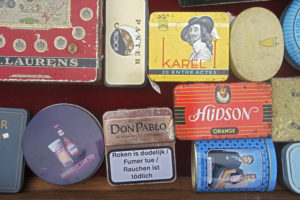
Looking for a solution? We can help.
Headquarters
9211 Corporate Blvd Ste 110
Rockville MD 20850
Satellite Offices
Dallas, TX
Paris, France
San Francisco, CA
Scottsdale, AZ
info@vivaboxsolutions.com
Phone
800-529-1988
Minimum Order Quantities:
RPET Totes: 3,000
Kraft Shoppers: 5,000
Rigid Boxes: 3,000
Folding Cartons: 5,000
It’s Not Medieval; It’s a Renaissance: Why Retail Isn’t Dead
Loyalty
We hear it quite a bit these days: online shopping is killing brick and mortar retail. It’s only a matter of time before it runs traditional stores out of business. Malls are drying up, stores we all grew up with are going out of business, and comparison shopping with the swipe of a finger on a digital screen has customers leaving stores without a purchase because they can buy it online, or somewhere else, for less.
As of the last quarter of 2018, e-commerce sales account for just 9.9% of overall retail sales in the US. That means 90.1% of all purchases are still being made in physical stores. The increase in online sales is growing, which creates a digital disruption of brick-and-mortar, but retail is far from dead and buried. To remain competitive in today’s mobile-fueled marketplace, retailers need to pay closer attention to market demand and conform their stores to changing consumer habits. Better yet, set a new standard for shopping and buying.
Despite the gloomy forecasts of retail, consumers still enjoy the instant gratification that comes from buying products in person instead of waiting for delivery (even if it’s only a day or a few hours). They enjoy the experience of shopping–not necessarily the simple act of purchasing. Those are two different emotions and should be catered to separately. They love a clever, or attractive, package that they can hold and inspect which might offer a spark of wonder and intrigue — all before they buy. They love a curated box that speaks to their inner “foodie” or “self-care” opportunity.
They want to explore new products and brands to break out of the same-old experiences they are used to. They want products (and services) that make them feel catered to and special. Even those on tight budgets love a little luxury that comes with experiential, adventurous shopping. They want beautiful environments with lovely smells, soft items to “pet,” and products with a wow factor (for themselves and others).
Moreover, the products consumers buy from retail stores are not just items they may need or want, but these items are also like souvenirs they bring home from the stores they frequent. I have been in eye-catching stores with beautiful set-ups and soft lighting, and I found myself wanting to buy something, even if it is a small item because I wanted to take a piece of that experience home with me.
As long as retailers are differentiating themselves on unique products and more remarkable shopping experiences (including exceptional customer service, BOPIS services, vibrant environments, and corresponding digital channels that pair well with their stores), it is easy to recognize that physical retail isn’t dead at all. The atmosphere is quite robust for stores that listen to consumer demands and think like consumers, not like legacy retailers.
Stop into Hudson Yards in NYC for a view into experimental retail spaces — touchable art, IG-friendly stores (Atelier Cologne), food halls and unique food stops (David Chang’s Fuku), landmark experiences (The Vessel), boutique coffee (Blue Bottle), stores that offer self- or assisted-checkout (Stance, Dirty Lemon), alongside a family-friendly sweets-and-games experience from Snark Park — all as ways to bring stickiness (borrowing from digital here) to an environment. And it’s working. Try not to feel wowed when you walk in.
Apocalyptic retail forecasts are only accurate for companies that continue down the “one-size-fits-all” branding and dull store experiences where products are stacked on shelves to get lost in the clutter. There is significant opportunity to take advantage of the 50% year-over-year growth that still exists in physical retail–it just has to be different than what has been done in the past.
Learn more about how Vivabox can curate exploratory, experiential packaging for your products to meet current consumer demands and offer your company better options and fresh SKUs for growth in the changing retail landscape.
Looking for a solution? We can help.
Headquarters
9211 Corporate Blvd Ste 110
Rockville MD 20850
Satellite Offices
Dallas, TX
Paris, France
San Francisco, CA
Scottsdale, AZ
info@vivaboxsolutions.com
Phone
800-529-1988
Minimum Order Quantities:
RPET Totes: 3,000
Kraft Shoppers: 5,000
Rigid Boxes: 3,000
Folding Cartons: 5,000
What a White Label VIP Customer Care Service Could Add to Your Business
Loyalty
As a business looking for opportunities to get ahead in the marketing and service focus of modern retailing, your first instinct may be to do it all yourself. Unfortunately, that is not always the best solution.
Building a customized, high-touch VIP customer care solution from scratch by attempting to meet the exact specifications of your business can be time-consuming and complicated. That’s because building your own solution can lead you to make mistakes, like spending too much money developing tools and solutions that already exist in other formats, or you may miss out on resources and expertise in the specific space where you need a focused solution. Or you simply don’t have the bandwidth to train, monitor, and launch a specialized high-touch customer service team.
These pitfalls are easy to avoid if you opt for a white label solution, rather than building one yourself. White label products and services, like the Vivabox VIP White Label Customer Care Service, help you deliver on your Brand Promise & Customer Care commitment using our outsourced team who operate under your “banner” — that’s the white label part.
Vivabox’s White label VIP Customer Care Service offers you the following benefits:
-
High-touch, limited quantity & limited time only rewards, gifts, influencer packages, and pop-up shop gifts, and special experiences need a specialized customer care team experienced in delivering above and beyond. We do that for you.
-
Our team uses software, yes, but they’re people. Real people. Customer care experts adept at delivering special products and special value to your most important customers.
-
It’s quick and easy to brand. We represent your aesthetic, tone, and service level as if it was…you! White label solutions are generally fully integrated, which makes branding easy. You can be free from concerns about needing to spend time and money on research or development because white label services are doing the work for you. Simply enough, we help propel your brand’s experience for you so you don’t have to cut corners that could backfire on your brand identity.
-
You can scale your services portfolio. The most significant benefit of using white label marketing is to broaden your offerings. You don’t need to specialize in each and every service that you offer, and outsourcing provides a much broader range of services for your business.
-
You can focus on your core competencies. Core competencies benefit from scaling your services. In many cases, the solutions that companies hope to build themselves fall far outside of their areas of expertise. It’s not smart to stretch your resources to do something that doesn’t fit within your core competencies. Pre-packaged solutions offer your business an opportunity to trust the experts in the specific space you are focused on, and avoid making the same mistakes that others have made before you.
-
Improve your customer loyalty, retention, and NPS. Broaden your rewards and event strategies. With a third-party provider taking responsibility for most important service delivery, you can focus more time and effort on managing your retail spaces, relationships, and product array. Every time your Growth or Marketing team comes to you with a special promotion, or award tier, you won’t have to say no to them just because you don’t have the capabilities in-house.
White label solutions, like the one Vivabox provides, help businesses use unique branding and high-touch customer care so you can offer a product or service without investing in infrastructure or technology creation. Done and done — at the speed of today’s retail environment.
Looking for a solution? We can help.
Headquarters
9211 Corporate Blvd Ste 110
Rockville MD 20850
Satellite Offices
Dallas, TX
Paris, France
San Francisco, CA
Scottsdale, AZ
info@vivaboxsolutions.com
Phone
800-529-1988
Minimum Order Quantities:
RPET Totes: 3,000
Kraft Shoppers: 5,000
Rigid Boxes: 3,000
Folding Cartons: 5,000
5 Retail Trends You Can Actually Activate for 2019
Loyalty
In 2019, the market will be defined by emerging technologies that change the way consumers interact with their favorite brands, a more tangible experience (online and on-site), and the emergence of new types of e-commerce.
Let’s take a look at five important trends that will shape retail in 2019 and forward.
1. Brand as Culture
Millennials’ changing preferences and attitudes regarding corporate responsibility and social consciousness have already impacted how retail brands present and position themselves. The trend has resulted in brands equating their internal culture with their exterior identity. Companies are increasingly engaging consumers outside of traditional shopping parameters and becoming cultural figures.
What ideas can you bring to market if you think of physical intercepts as a cultural representation of the connection you have with your consumers vs “buy it now”
Companies can embrace physical and ideological experiences that immerse customers into a full buyer’s cycle. The days of clever campaigns being enough are pretty much done. Companies will have to consider the image their brand conveys to the world in ethos, all senses, and in packaging (which are blending more than ever).
2. Experiential Retail
The old model of in-store and online retail strictly focused on products being sold. However, consumers have been moving away from strictly shopping for products and are now searching for a more engaging experience. The trend has been primarily driven by millennials and their preference for experiences over things.
Consumers are shopping more with their emotions rather than their wallets. Note, we said shopping. Physically walking into a store should be an escape, a chance to browse, a chance to meander. Buying, on the other hand, is assumed to be pretty quick and easy — a few clicks, done.
Re-designed signage and remodeling a store aren’t enough, both the stores and the brands now realize they can only survive if they create something worth visiting.
For example, stores like Sephora have rethought their retail experiences by combining traditional elements, trial, loyalty programs, and their mobile apps pretty seamlessly. (they’re a client, we’re biased)
Samsung unveiled a $43 million “pop-up” that features its products but doesn’t have any for sale.
The emergence of virtual reality, augmented reality, and improved mobile connectivity have added new layers of experience to add to their retail models.
Packaging for online and on-site stores has also emerged as an essential experiential touchpoint. Gone are the days of brown boxes with packaging tape, bubble wrap, and packing peanuts as “the last mile experience.“
Consumers want their packaging to mean something more. To mean something, actually. Colors, fonts, textures, and materials are all a selling point, as well as its ability to be recycled or repurposed. It’s almost as important as the product it holds.
3. Faster Shipping
E-commerce continues its march toward becoming the most popular purchasing medium. In September 2018 the sector expanded by 11.4%. Today, most major brands have an online presence, and they all offer comparable prices. Even stores like Amazon and Walmart have become largely competitive, so retailers seeking to differentiate themselves have had to find other ways to deliver value.
A current Marketing Charts study found that the amount of time people are willing to wait for free shipping has dropped from 5.5 days in 2012 to 4.5 days on average. Programs like Amazon Prime have made two-day shipping the standard, so cutting down on shipping time is vital for any e-commerce business looking to stay on top.
In-store pick-up, new delivery systems, special access, or making the package worth waiting for are all ways to combat warp speed expectations.
4. Subscription E-Commerce
Today’s buyers are also increasingly seeking shopping/buying that is tailored to their preferences and delivered directly to their doors. These trends have resulted in the emergence of subscription e-commerce, which means businesses curate products and ship them to customers with regularity.
According to a recent report by McKinsey & Company, 15% of online consumers signed up for subscription services in 2017, and that trend is only growing.
That said, marketing and maintaining a subscription base can be expensive for some brands and retailers. This is an area where a well-defined test is a must.
5. Multi-Channel, aka Omnichannel, aka The Way Consumers Shop & Buy Naturally in 2019
Even though many brick-and-mortar stores are closing, they still play a significant role in the purchase process. The difference is that it has transitioned from the primary point of sales to being part of a broader retail strategy. Instead of a single touchpoint for consumers, the growing trend in retail has been to expand how brands use brick-and-mortar to catch leads and convert them.
How can retailers maintain omnichannel active and keep personalization and fulfillment streamlined?
This calls for deep integration across all channels, including websites, marketplaces, social media, and brick-and-mortar. It’s time to get departments really working together, and sharing data, and thinking differently about sales attribution. The consumer is already fluid, but most retailers and brands are less so.
Multi-channel is vital for captivating consumers and keeping them engaged from first impressions to the point of sale. Focusing on providing excellent experiences across channels is the best way to stay vital in the upcoming years. Oh how we love a good CX strategy.
The latest trends in retail are driven by a combination of a changing technological landscape and the shifting preferences of consumers created by millennials. By embracing these trends and preparing for them, retailers can look to 2019 as another favorable opportunity to grow.
Looking for a solution? We can help.
Headquarters
9211 Corporate Blvd Ste 110
Rockville MD 20850
Satellite Offices
Dallas, TX
Paris, France
San Francisco, CA
Scottsdale, AZ
info@vivaboxsolutions.com
Phone
800-529-1988
Minimum Order Quantities:
RPET Totes: 3,000
Kraft Shoppers: 5,000
Rigid Boxes: 3,000
Folding Cartons: 5,000
Know Your Customer: Developing Personas for Packaging Strategy
Loyalty
The key to a successful marketing or branding campaign starts with understanding your target audience, and, a well-defined audience begins with developing buyer personas. In the age of IG and e-commerce, your primary and secondary packaging design should most definitely be part of your CX process and strategy.
A buyer persona is defined as a well-developed character created from customer trends and demands. Most companies attract more than one group of people, so they find it beneficial to develop three-dimensional personalities with names, ages, occupations, certain social statuses, education levels, aesthetic principles, family size, buying trends, and more. Brands interact with people, not cardboard cutouts, so developing these personas are helpful to create a range of insights.
Simply put, developing personas is important, and it is incredible what insights surface when companies take the time to get to know them.
Personas and Packaging
When thinking about brand development and the multiple personas you must nurture, packaging becomes a primary touchpoint. Outside of the actual product, the package is the most tangible branding tool a business has, and these personalities can have a significant impact on your design strategy.
For example, if you’re targeting an older persona, you may want to work with more traditional packaging or play with nostalgic designs that tug at their heartstrings or work with packaging that can be repurposed. You also want to assess your font size and contrast and including smart and obvious ways to open the package for hands that have lost some dexterity.
If you’re going to attract a millennial persona, you may want to develop a more sustainable solution that works with contemporary or forward-looking design and trends. And be sure it has an element of IG-bait.
Packaging the same product in different ways can be a great way to embrace all of your personas without exclusion.
The Power of Personas
Once your business has developed well-rounded personas, what can you do with them? You can do anything! Hopefully, you use them to make every brand decision. Considering that it is the consumer that creates demand, it is essential that all marketing and branding strategies keep all personas in the forefront of every decision.
Consulting personas for insights into what your audience will identify with and what will capture their interest is essential to determining the shape, font, color, textures, and materials you use in your packaging design.
As you develop your packaging for your personas, don’t forget to measure your successes and room for improvement. Analyzing past data and current customer responses is a great way to test if your packaging ideas are meeting consumer standards and how they may be changing. Don’t let your personas get stagnant. They should be an ever-changing point of reference to keep your brand, and packaging, moving forward.
Looking for a solution? We can help.
Headquarters
9211 Corporate Blvd Ste 110
Rockville MD 20850
Satellite Offices
Dallas, TX
Paris, France
San Francisco, CA
Scottsdale, AZ
info@vivaboxsolutions.com
Phone
800-529-1988
Minimum Order Quantities:
RPET Totes: 3,000
Kraft Shoppers: 5,000
Rigid Boxes: 3,000
Folding Cartons: 5,000
How to Create the Best Brand Experiences in a Box for ROI, Growth, and Loyalty
Loyalty
Nearly every client asks us how to build the best box ever made. I’ll tell you. Apply consumer and influencer insights to create a sense of wonder. Why?
When we review performance stats with our clients and brands, we found a commonality among the most successful ones, and it has a lot to do with humanity and our world today. Sounds huge, but it’s manageable, let me explain. It boils down to our complex desire to experience wonder – if only for a moment – in an age when we’re feeling more disconnected and the velocity of life is catapulting us to what’s next quicker than ever. Wonder and tactile, authentic experiences have been stripped away in today’s era of insta-everything. We want to be surprised, but also in the know. We want to feel something and sink into a moment but also curate our response. Filter your consumer insights through this lens to create the highest ROI, best performing “brand experiences in a box,” that’s the secret. B2B, B2C, same application.
In today’s digital, volatile world human nature’s response is to seek self-expression, optimism, purpose, and natural narratives.
Our senses send complex messages to let our brains know what is going on around us.
Our five senses, Smell, Touch, Taste, Vision, and Hearing, work together to explain what our world is. However, when the world’s volatility and human connection rock off their axis, we seek ways to understand why our world is too – and that requires five additional senses to bring everything into focus again. Self-Worth, Saving Time, Feeling Special & Beautiful, Humor, and a Sense of Purpose combine to help us feel valued, present, and
In a word? We’re all seeking WONDER.
wonder | ˈwəndər | noun a feeling of surprise mingled with admiration, caused by something beautiful, unexpected, unfamiliar, or inexplicable: he had stood in front of it, observing the intricacy of the ironwork with the wonder of a child.
• the quality of a person or thing that causes wonder: Athens was a place of wonder and beauty.
• a strange or remarkable person, thing, or event: the electric trolley car was looked upon as the wonder of the age. • [as modifier] having remarkable properties or abilities: a wonder drug.
• [in singular] a surprising event or situation: it is a wonder that losses are not much greater.
Humans are seeking wonder, and brands are seeking two things: authenticity and embedded experiences. Think Supreme on the cover of the NY Post – a brand embedded into morning and evening commute times, and it was unexpected. Influencer Marketing promises to deliver both authenticity and embedded access to consumer’s lives. Done well, it can (and frankly, trial, education, discovery, and loyalty kits can too) if you look at them as more than product delivery.
Give your consumers and influencers a way to editorialize with their own voice and style, save them time, be sure they feel important, sometimes a sense of humor can break through, and don’t assume they know what your higher brand purpose is. Show them with an extraordinary narrative they can believe in.
Our minds were not developed to thrive solely on digital experiences. Yes, it’s just a box, but it gives us something we crave. Sensorial, tangible experiences and bite-size trial in a world of overwhelming choice.
What does your kit feel like? Smell like? How does it make someone feel? Can it help them immediately save time or feel better about themselves? Do they know what your brand purpose is? Better yet, can they feel it?
That’s a win, every time.
Looking for a solution? We can help.
Headquarters
9211 Corporate Blvd Ste 110
Rockville MD 20850
Satellite Offices
Dallas, TX
Paris, France
San Francisco, CA
Scottsdale, AZ
info@vivaboxsolutions.com
Phone
800-529-1988
Minimum Order Quantities:
RPET Totes: 3,000
Kraft Shoppers: 5,000
Rigid Boxes: 3,000
Folding Cartons: 5,000





